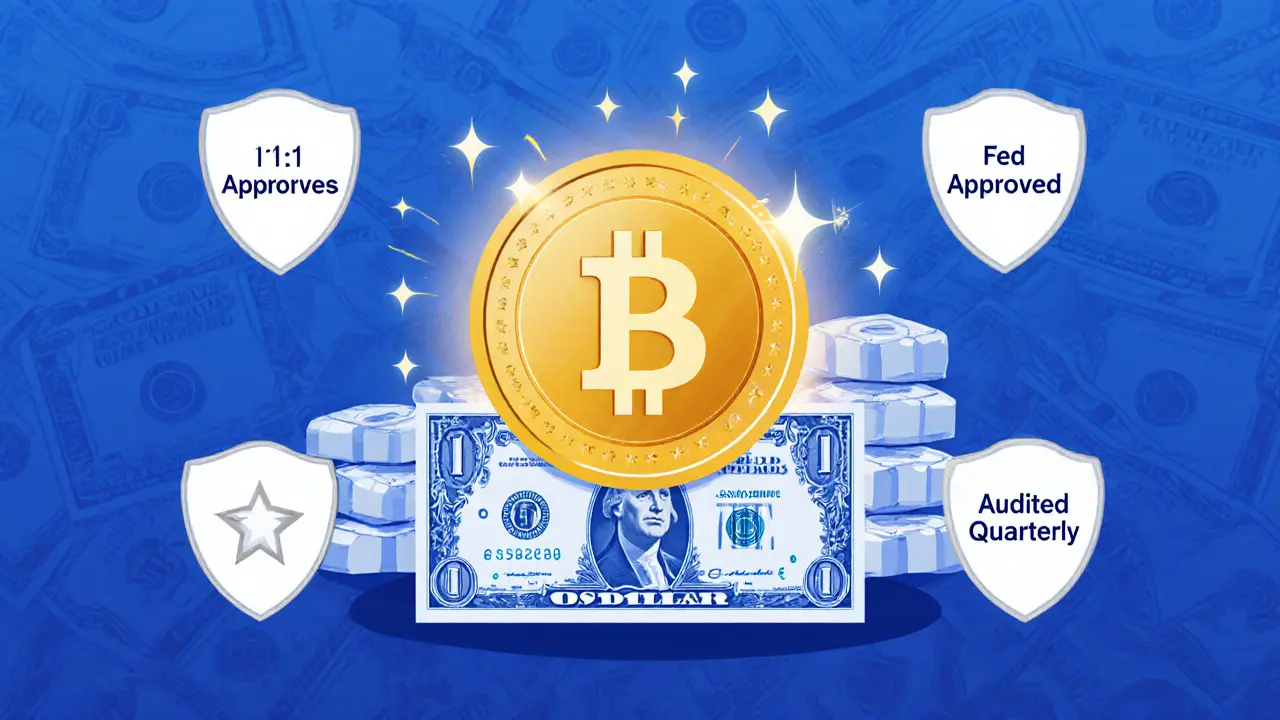GENIUS Act: What the New Federal Stablecoin Framework Means for Users and Issuers
 Apr, 14 2025
Apr, 14 2025
Stablecoin Issuer Eligibility Checker
Check if your organization meets the federal requirements to issue stablecoins under the GENIUS Act. The law requires licensed financial institutions with proper reserves and compliance.
Eligibility Checklist
Eligibility Result
Please complete the eligibility checklist above and click "Check Eligibility" to see if your organization meets the GENIUS Act requirements.
The GENIUS Act isn’t just another piece of financial paperwork. It’s the first time the U.S. federal government has laid down clear, enforceable rules for stablecoins - the digital tokens designed to hold steady at $1 each, backed by real money. Signed into law on July 18, 2025, this legislation changes everything for anyone who uses, issues, or invests in stablecoins. No more guessing. No more loopholes. Just rules - strict ones.
Who Can Issue Stablecoins Now?
Before the GENIUS Act, anyone with a website and a wallet could launch a stablecoin. Now, only licensed institutions can. That means banks, credit unions, and certain nonbank financial firms that get explicit approval from the Federal Reserve. No more anonymous crypto startups issuing tokens backed by questionable assets. The law shuts that door. If you want to issue a payment stablecoin in the U.S., you need a charter, a balance sheet, and a track record of compliance. It’s not about stopping innovation - it’s about making sure innovation doesn’t put your money at risk.
1:1 Reserves Are Non-Negotiable
One of the biggest fears about stablecoins has always been: "What if they’re not really backed?" The GENIUS Act answers that with a hard rule: every stablecoin in circulation must be backed by $1 in real assets. These aren’t just any assets. They have to be cash, U.S. Treasury bills, repurchase agreements, or other low-risk instruments approved by regulators. No corporate bonds. No crypto. No vague "reserve pools" with opaque holdings. Every issuer must publicly report what’s in their reserves, and an independent audit firm must verify it every quarter. If you’re holding a U.S. dollar-backed stablecoin after January 2027, you can be confident it’s not a house of cards.
Anti-Money Laundering Is Built In
Stablecoins have been used for everything from paying freelancers to moving illicit cash. The GENIUS Act forces issuers to treat them like traditional financial instruments. That means full compliance with the Bank Secrecy Act - know-your-customer checks, transaction monitoring, suspicious activity reports. If you’re sending $10,000 in stablecoins, the issuer has to know who you are. If you’re trying to move money through multiple wallets to hide its origin, you’ll hit a wall. This isn’t just about catching criminals. It’s about making stablecoins trustworthy enough for everyday use - payroll, rent, grocery bills - without raising red flags from regulators.

What Issuers Can’t Do
The law doesn’t just set minimum standards - it draws hard lines. Issuers can’t rehypothecate your reserve assets. That means they can’t lend out your $1 in Treasury bills to someone else to earn extra profit. They can use those assets in short-term repurchase agreements (repos) to maintain liquidity, but only if the deal is cleared through an approved central counterparty and approved by regulators. They also can’t mix your stablecoin reserves with their own corporate funds. Your money must be held separately, in a locked box, so even if the issuer goes bankrupt, your stablecoins are still backed.
And here’s something most people don’t realize: the act explicitly protects self-custody. If you use a hardware wallet or a non-custodial app to store your own private keys, the company that made the wallet doesn’t have to follow these rules. The law targets issuers - not toolmakers. That’s a win for privacy and control.
The Stablecoin Certification Review Committee
Behind the scenes, a new body called the Stablecoin Certification Review Committee (SCRC) holds real power. Chaired by the Treasury Secretary and including the Fed Chair and FDIC Chair, this committee decides whether state-level stablecoin rules are "substantially similar" to the federal ones. If a state’s rules are weaker, the SCRC can block state-issued stablecoins from operating nationally. That’s a big deal. It means the federal government isn’t just setting the floor - it’s trying to set the ceiling. The goal? One set of rules for the whole country. No more patchwork of conflicting regulations between New York, Wyoming, and California.
But Is It Perfect?
Not quite. The biggest gap? State-issued stablecoins. The GENIUS Act doesn’t ban them. It just says they can’t operate across state lines unless they meet federal standards. So you could still see a Wyoming-based stablecoin that follows looser rules - but only if you’re okay using it within Wyoming. That creates a two-tier system: federal stablecoins, which are safe and widely accepted, and state-level ones, which might be cheaper or faster but riskier.
Also, the law doesn’t cover all types of stablecoins. Only "payment stablecoins" - those meant to be used like cash. Algorithmic stablecoins (like the ones that try to stay pegged using code, not reserves) and commodity-backed tokens (like gold-backed coins) are outside the scope. That’s intentional. The lawmakers focused on the most widely used, most risky, and most impactful type first.

What This Means for You
If you’re a regular user: your stablecoins are safer than ever. You can trust that your $100 in USDC or USDT (if issued by a compliant entity) is actually backed by real U.S. Treasuries. No more Terra-style collapses. No more sudden depegs.
If you’re a business: you now have a clear path to integrate stablecoins into your operations. Payroll, international payments, supply chain settlements - all can be done with confidence. Companies like PayPal and Stripe are already preparing to apply for issuer licenses.
If you’re a developer: you can build on a stable foundation. Smart contracts, DeFi protocols, and wallet apps can now assume that the stablecoins they interact with are regulated, audited, and compliant. That reduces legal risk and opens the door for institutional adoption.
Why It Matters Beyond the U.S.
The U.S. dollar is the world’s reserve currency. Now, the U.S. is trying to make the dollar-backed stablecoin the world’s default digital currency. Other countries are watching closely. Hong Kong passed its own stablecoin law in May 2025. The European Union has MiCA. But the U.S. market is the largest, and its rules will set the tone. If your stablecoin wants to be used globally, it’s going to need to meet U.S. standards - because that’s where the money flows.
The GENIUS Act isn’t about stopping crypto. It’s about bringing it into the financial mainstream - safely. It turns stablecoins from a wild west experiment into a regulated financial tool. That’s not a defeat for innovation. It’s the next step.
When Does It Start?
The law takes effect on January 18, 2027 - or 120 days after the final rules are published, whichever comes first. That gives issuers 18 months to get ready. If you’re holding stablecoins now, don’t panic. They’re still usable. But after the deadline, only compliant issuers can operate. If your favorite stablecoin disappears from your wallet, it’s not a glitch - it’s the law.
What stablecoins are covered by the GENIUS Act?
Only payment stablecoins - digital assets designed to be used as a medium of exchange and redeemable 1:1 for U.S. dollars or other fiat currency. Algorithmic stablecoins, commodity-backed tokens, and non-payment tokens like utility or governance tokens are not included.
Can I still use USDC or USDT after the GENIUS Act?
Yes - but only if the issuer (like Circle or Tether) gets federal approval. Both companies have already announced plans to apply for licenses. If they don’t, those tokens will no longer be legally issued in the U.S. after January 2027.
Does the GENIUS Act ban decentralized stablecoins?
It doesn’t ban them directly, but it makes them impractical. If you’re running a decentralized protocol that mints a stablecoin without a regulated issuer, you’re not breaking the law - but no bank, exchange, or payment processor will touch it. Without access to the traditional financial system, decentralized stablecoins will be isolated and unusable for most real-world transactions.
Can I hold stablecoins in my own wallet?
Absolutely. The GENIUS Act doesn’t restrict how you store your stablecoins. Whether you use a hardware wallet, a non-custodial app, or a phone app, you’re free to self-custody. The law only regulates the issuers - not the users or the tools you use.
Will the GENIUS Act make stablecoins more expensive to use?
Possibly. Compliance costs - audits, reserve reporting, AML systems - will raise operating expenses for issuers. Some may pass those costs to users in the form of higher fees or lower interest on reserves. But the trade-off is safety. For most people, paying a little more for guaranteed backing is worth it.
What happens to state-issued stablecoins?
They can still exist - but only within the state that issued them. If a state’s rules aren’t approved as "substantially similar" by the federal SCRC, those stablecoins can’t be used across state lines or on national platforms. This creates a patchwork, but federal issuers will dominate because they’re usable everywhere.
Does the GENIUS Act affect crypto exchanges?
Not directly - but indirectly, yes. Exchanges must stop listing unapproved stablecoins after the deadline. They’ll also need to verify that the stablecoins they support are issued by licensed entities. This pushes exchanges to partner only with compliant issuers, further consolidating the market.
Is the GENIUS Act good for innovation?
Yes. Clear rules reduce legal risk. When companies know what’s allowed, they invest. Startups building payment apps, DeFi tools, or cross-border remittance services can now build on a stable, regulated foundation instead of dodging regulators. Innovation thrives with boundaries - not chaos.
Emily Michaelson
November 23, 2025 AT 14:36The GENIUS Act is a game-changer for everyday users. Finally, we have real transparency on reserves. No more guessing if your USDC is backed by T-bills or random crypto junk. I’ve been holding stablecoins for years, and this is the first time I feel like my money is actually safe. The quarterly audits? Mandatory public disclosures? That’s not bureaucracy - that’s basic accountability. And the fact they’re protecting self-custody? Huge win. You can still hold your keys, no one’s taking that away. This isn’t crypto’s death - it’s its coming of age.
David Hardy
November 24, 2025 AT 06:30finally someone in gov actually got it 😎
John Borwick
November 26, 2025 AT 00:16man i’ve been waiting for this for years
remember when you could just spin up a stablecoin on a weekend and call it a day
now you gotta have a balance sheet and a compliance team
sure it’s slower but think about it
how many people lost everything because someone cooked the books
terra was a disaster but it wasn’t the first
and it won’t be the last if we don’t lock this down
the fact they’re banning rehypothecation is huge
that’s the exact trick that blew up a bunch of crypto firms
your $1 isn’t being lent out to some hedge fund
it’s sitting in a T-bill locked in a vault
and the SCRC? smart move
no more Wyoming loophole where you pretend you’re regulated but you’re not
if you want to play in the big leagues you play by the big rules
and yeah i get it
some folks are gonna pay higher fees
but is a 0.5% fee worth peace of mind
absolutely
this is how you build trust
not by hype
but by hard rules